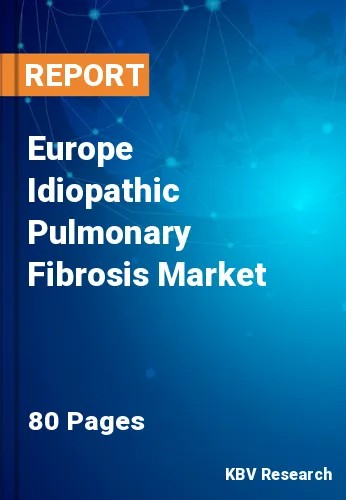The Europe Idiopathic Pulmonary Fibrosis Market would witness market growth of 6.1% CAGR during the forecast period (2021-2027).
Factors such as shifting lifestyle patterns, rising nicotine product usage, and growing health awareness among the general public about efficient IPF management measures are directly proportional to the growth of the overall industry. In addition to pharmacological treatments, IPF patients get a variety of non-pharmacological treatments. Lung transplants, mechanical ventilation, oxygen therapy, and pulmonary rehabilitation are the most common non-pharmacological treatments. In general, the treatment strategy for IPF is mostly determined by the patient's symptoms, illness stage, and overall health.
Incidence and death rates would rise, and the prevalence of the disease is projected to climb as the population ages. In addition, occupational and environmental exposures, gastric reflux, and hereditary factors are all potential risk factors. Moreover, progressive fibrosis with loss of normal lung tissue results in restricted gas exchange, decreased ventilation, respiratory discomfort and exercise limitation, poor quality of life, and eventually death.
In industrialized countries such as the United Kingdom, the elderly population is growing, and those over the age of 60 are more susceptible to lung diseases. In Western European countries, a large proportion of elderly persons are admitted to hospitals due to respiratory difficulties. In addition, to obtain important clinical proof for their treatments, market companies are forming partnerships with major organizations such as the National Institutes of Health.
According to the European Pulmonary Fibrosis Patient Charter, around 80,000 to 111,000 persons in Europe suffer from IPF, with 30,000 to 35,000 patients diagnosed each year. According to 2017 research by the National Centre for Biotechnology Information (NCBI), 54 percent of patients in Europe do not receive any antifibrotic medication. In 2019, 18.4 percent of EU citizens aged 15 and above reported smoking cigarettes on a daily basis. In fact, just 12.6 percent of EU citizens smoked less than 20 cigarettes per day, whereas 5.9 percent smoked 20 or more cigarettes per day. Such factors reveal the high susceptibility of the regional population towards lung-related diseases.
The Germany market dominated the Europe Idiopathic Pulmonary Fibrosis Market by Country 2020, and would continue to be a dominant market till 2027; thereby, achieving a market value of $291.1 million by 2027. The UK market is experiencing a CAGR of 5.3% during (2021 - 2027). Additionally, The France market would exhibit a CAGR of 6.9% during (2021 - 2027).
Based on Drug Type, the market is segmented into Pirfenidone and Nintedanib. Based on Distribution Channel, the market is segmented into Retail Pharmacies, Hospital Pharmacies, and Online Providers. Based on countries, the market is segmented into Germany, UK, France, Russia, Spain, Italy, and Rest of Europe.
Free Valuable Insights: The Global Idiopathic Pulmonary Fibrosis Market Size will Hit $4.7 Billion by 2027, at a CAGR of 6.9%
The market research report covers the analysis of key stake holders of the market. Key companies profiled in the report include GNI Group Ltd., Shionogi & Co., Ltd., Mission Therapeutics Ltd., Galapagos NV, FibroGen, Inc., AstraZeneca PLC, F. Hoffmann-La Roche Ltd., Bristol Myers Squibb Company, Boehringer Ingelheim International GmbH, and Biogen, Inc.
By Drug Type
By Distribution Channel
By Country
Our team of dedicated experts can provide you with attractive expansion opportunities for your business.

